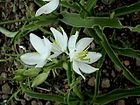Note: This is a project under development. The articles on this wiki are just being initiated and broadly incomplete. You can Help creating new pages.
Difference between revisions of "Chlorophytum tuberosum"
| Line 6: | Line 6: | ||
===Food=== | ===Food=== | ||
| − | Chlorophytum tuberosum can be used in Food. Tender leaves are cooked as vegetable. Tubers are eaten raw. | + | Chlorophytum tuberosum can be used in Food. Tender leaves are cooked as vegetable. Tubers are eaten raw<ref name="Forest foods of Western Ghat"/>. |
==Parts Used== | ==Parts Used== | ||
| Line 33: | Line 33: | ||
===Nutritional components=== | ===Nutritional components=== | ||
| − | Chlorophytum tuberosum contains the Following nutritional components like - Vitamin-C; Glycoside; Hemicellulose; Mucilage; Calcium, Copper, Iron, Magnesium, Manganese, Phosphorus, Sodium Zinc<ref name=" | + | Chlorophytum tuberosum contains the Following nutritional components like - Vitamin-C; Glycoside; Hemicellulose; Mucilage; Calcium, Copper, Iron, Magnesium, Manganese, Phosphorus, Sodium Zinc<ref name="Forest foods of Western Ghat"/> |
==Habit== | ==Habit== | ||
| Line 58: | Line 58: | ||
==Cultivation Details== | ==Cultivation Details== | ||
| − | Chlorophytum tuberosum is available through June to September<ref name=" | + | Chlorophytum tuberosum is available through June to September<ref name="Forest foods of Western Ghat"/> |
==Commonly seen growing in areas== | ==Commonly seen growing in areas== | ||
| Line 73: | Line 73: | ||
<ref name="Leaf">[Morphology]</ref> | <ref name="Leaf">[Morphology]</ref> | ||
<ref name="How to plant/cultivate">[Cultivation details]</ref> | <ref name="How to plant/cultivate">[Cultivation details]</ref> | ||
| − | <ref name=" | + | <ref name="Forest foods of Western Ghat">"Forest food for Northern region of Western Ghats" by Dr. Mandar N. Datar and Dr. Anuradha S. Upadhye, Page No.50, Published by Maharashtra Association for the Cultivation of Science (MACS) Agharkar Research Institute, Gopal Ganesh Agarkar Road, Pune</ref> |
</references> | </references> | ||
Revision as of 11:50, 27 October 2021
Chlorophytum tuberosum is a herb usually growing up to 20–50 cm tall. Its underground parts comprise a short rhizome, often surrounded by fibres, which bears swollen roots with dark tubers to up 7 cm long at their tips.
Contents
- 1 Uses
- 2 Parts Used
- 3 Chemical Composition
- 4 Common names
- 5 Properties
- 6 Habit
- 7 Identification
- 8 List of Ayurvedic medicine in which the herb is used
- 9 Where to get the saplings
- 10 Mode of Propagation
- 11 Cultivation Details
- 12 Commonly seen growing in areas
- 13 Photo Gallery
- 14 References
- 15 External Links
Uses
Obesity, Diabetes, Leucorrhea, Pregnancy problems.
Food
Chlorophytum tuberosum can be used in Food. Tender leaves are cooked as vegetable. Tubers are eaten raw[1].
Parts Used
Chemical Composition
Common names
| Language | Common name |
|---|---|
| Kannada | |
| Hindi | Safed-musli |
| Malayalam | |
| Tamil | |
| Telugu | |
| Marathi | Kuli |
| Gujarathi | |
| Punjabi | |
| Kashmiri | |
| Sanskrit | |
| English | Edible Chlorophytum |
Properties
Reference: Dravya - Substance, Rasa - Taste, Guna - Qualities, Veerya - Potency, Vipaka - Post-digesion effect, Karma - Pharmacological activity, Prabhava - Therepeutics.
Dravya
Rasa
Guna
Veerya
Vipaka
Karma
Prabhava
Nutritional components
Chlorophytum tuberosum contains the Following nutritional components like - Vitamin-C; Glycoside; Hemicellulose; Mucilage; Calcium, Copper, Iron, Magnesium, Manganese, Phosphorus, Sodium Zinc[1]
Habit
Identification
Leaf
| Kind | Shape | Feature |
|---|---|---|
Flower
| Type | Size | Color and composition | Stamen | More information |
|---|---|---|---|---|
| {{{5}}} |
Fruit
| Type | Size | Mass | Appearance | Seeds | More information |
|---|---|---|---|---|---|
Other features
List of Ayurvedic medicine in which the herb is used
Where to get the saplings
Mode of Propagation
[[:Category:Index of Plants which can be propagated by |]]
Cultivation Details
Chlorophytum tuberosum is available through June to September[1]
Commonly seen growing in areas
In open areas of deciduous forests.
Photo Gallery
References
- ↑ 1.0 1.1 1.2 "Forest food for Northern region of Western Ghats" by Dr. Mandar N. Datar and Dr. Anuradha S. Upadhye, Page No.50, Published by Maharashtra Association for the Cultivation of Science (MACS) Agharkar Research Institute, Gopal Ganesh Agarkar Road, Pune
- ↑ [Chemical constituents]
- ↑ [Morphology]
Cite error: <ref> tag with name "How to plant/cultivate" defined in <references> is not used in prior text.
External Links
- [ ]
- [ ]
- [ ]
- Pages with reference errors
- Ayurvedic Herbs known to be helpful to treat Obesity
- Ayurvedic Herbs known to be helpful to treat Diabetes
- Ayurvedic Herbs known to be helpful to treat Leucorrhea
- Ayurvedic Herbs known to be helpful to treat Pregnancy problems
- Herbs with Tubers used in medicine
- Herbs with Leaf used in medicine
- Herbs with common name in Hindi
- Herbs with common name in Marathi
- Herbs with common name in English
- Habit - Herb
- Index of Plants which can be propagated by
- Herbs that are commonly seen in the region of In open areas of deciduous forests
- Herbs
- Pages without herbs images

